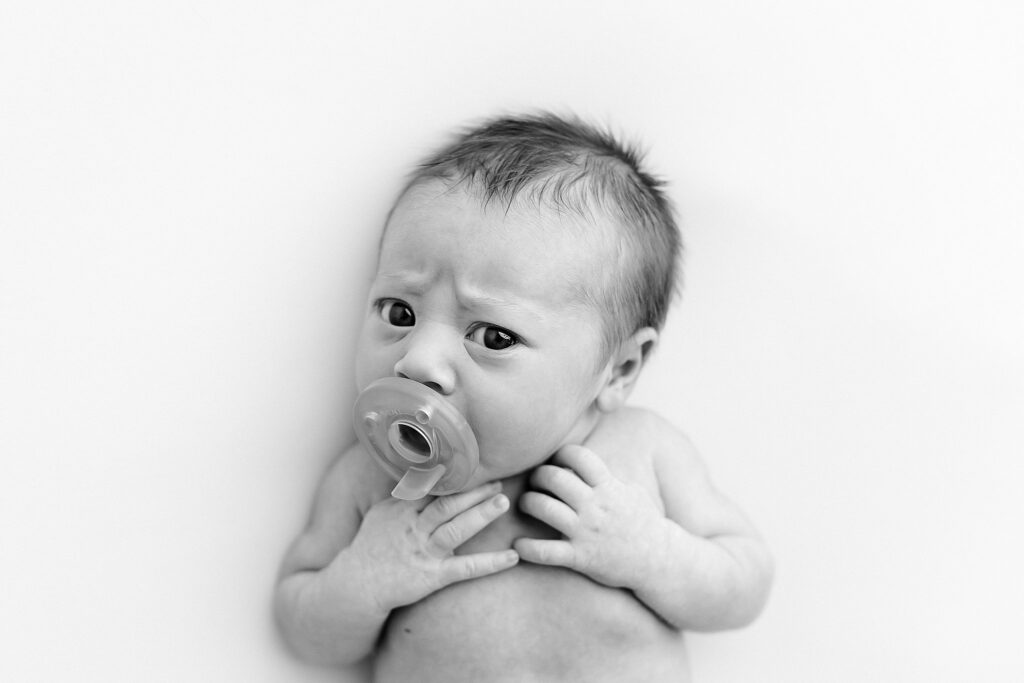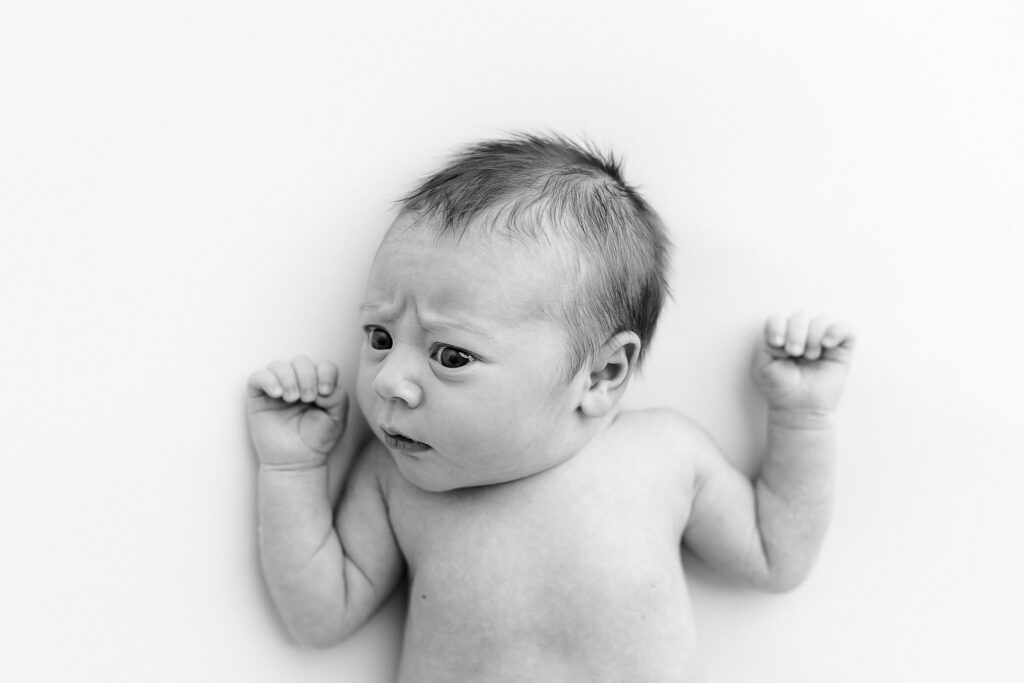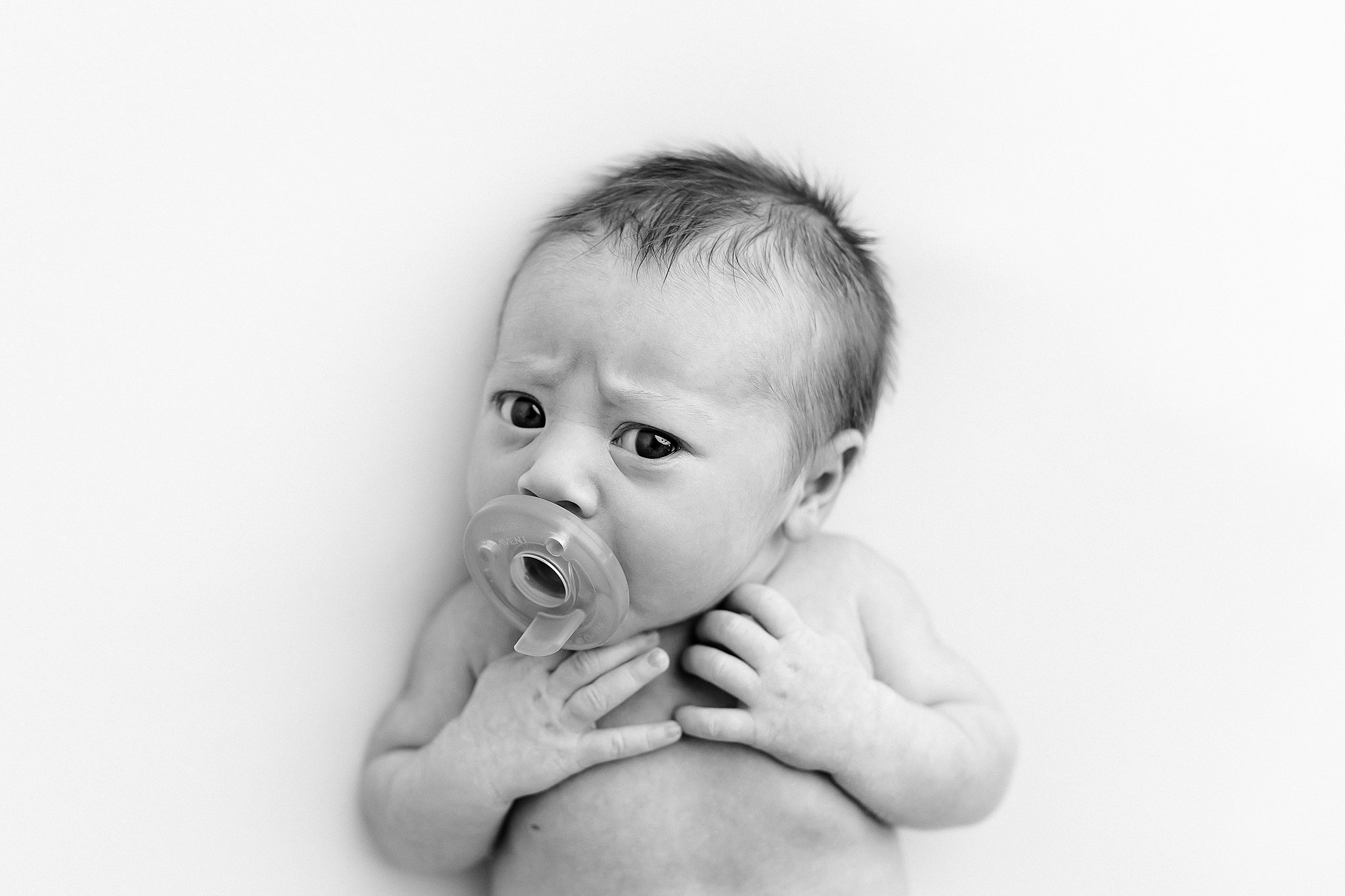Have you ever been sitting at your desk editing away and pondering newborn photo retouching ethics? Well, neither have I (not extensively anyway.) However, the other day I was scrolling through a newborn photography Facebook group and I saw a post that made me cringe.
A photographer was desperately seeking help removing a pacifier from a baby in the froggy pose—apparently the only decent shot she’d gotten before the baby “lost their shit.” She had another image of the same baby wrapped from overhead, but with completely different lighting and angle. She’d tried using AI to remove the pacifier but got an error.
My first thought wasn’t about which tool would work best—it was whether she should be doing this at all.
Commercial vs. Newborn Photo Editing Ethics
This situation immediately transported me back to my Nordstrom retouching days. I can’t tell you how many times I’d have to explain to art directors why we couldn’t just “push up” a sleeve in post-processing when the sample they photographed had long sleeves but the production garment would have 3/4 sleeves.
“There’s nothing underneath there!” I’d say, trying not to sound exasperated. “It’s a photograph. I need to completely rebuild the arm.”
I literally had a folder on my computer labeled “body parts” filled with arms, legs, and necklines that I could use to reconstruct these impossible requests. Weird? Absolutely. Effective? Also yes.
But here’s the critical difference between altering the model’s sleeve length and removing a baby’s pacifier:
The baby is someone’s child. We’re photographing an individual person, not a product.
The model’s arm? Not that important in the grand scheme of things—the shirt was the subject, not the model. As long as the replacement arm matched the model’s skin tone and looked realistic, it didn’t matter if it technically belonged to someone else.
But giving a baby someone else’s lips—or worse, AI-generated lips? That crosses into territory that makes me deeply uncomfortable.

Drawing the Line: My Personal Newborn Photo Retouching Ethics
Over my years as both a commercial retoucher and a newborn photographer, I’ve developed my own set of newborn photo retouching ethics that guide my decisions. Here’s where I personally draw the line:
What I Will Edit:
- Temporary conditions: Flaky skin, baby acne, jaundice, redness, or mild bruising from birth
- Distractions: Background elements, lint on blankets, temporary marks
- Color and tone: Adjusting white balance, enhancing the mood through color grading
- Composites: Combining images of the SAME baby from the SAME session when safety or comfort requires it
- Prop and Clothing shaping: Smoothing the line of a bulky warp or pushing in ill-fitting clothing bumps.
What I Won’t Edit:
- Permanent features: Birthmarks, moles, unique facial features
- Body shape: Slimming a baby’s natural rolls or changing their features
- Head shape: “Fixing” the natural shape of a baby’s head
- Major substitutions: Giving a baby someone else’s body parts or features
It’s Not Just About “Can You?” But “Should You?”
With tools like Photoshop and AI becoming increasingly powerful, the question isn’t whether we can make these edits—it’s whether we should.
Remember that folder of body parts I kept? I had the technical skill to replace the baby’s entire lower face with another baby’s mouth, or to generate a completely new one with AI. But technical ability doesn’t make it right.
If I composite in lips from another image of the same baby from the same session? That feels okay—it’s still authentically them, just from a different moment or outtake seconds earlier.
But borrowing another child’s features or having AI fabricate them? That’s rewriting reality in a way that feels dishonest to me, especially for a portrait meant to preserve this specific, unique person at this fleeting moment in time.
The Conversation We Need to Have with Clients About Editing Ethics
The most important aspect of newborn photo editing ethics is setting clear expectations with clients from the beginning. Here’s how I approach it:
- Be transparent about your editing philosophy before they book: “I enhance images but maintain your baby’s natural features and appearance.”
- Educate parents about the unpredictability of newborn sessions: “We’ll work with baby’s comfort level, which sometimes means adapting our plans.”
- Show them examples of your normal editing process: Before/after examples help set appropriate expectations.
- Have a conversation about permanent features: “I don’t remove birthmarks or alter your baby’s natural features because those are part of who they are. If there’s something temporary you’re concerned about, let’s discuss it.”
- Address specific concerns proactively: If a baby has something distinctive like a birthmark, ask the parents directly how they’d like you to handle it.
When Technology Outpaces Newborn Photo Editing Ethics
The rise of AI editing tools has brought editing ethics to the forefront in a new way. Just because we can now generate an entirely new baby face doesn’t mean we should.
In commercial product photography, the subject is the product—it doesn’t matter if the hand modeling the bracelet belongs to a completely different person than the face in the ad.
But in newborn photography, the baby IS the subject. Their unique features are precisely what we’re hired to document.
Every photographer needs to establish their own ethical framework. But here’s the biggest question to ask yourself: “How would I feel if this was my child?”



The Pacifier Dilemma: What I Would Do
So what about that pacifier in the froggy pose? Here’s how I would handle it:
- Be honest with the client: “I wasn’t able to get a clear shot without the pacifier because baby was uncomfortable.”
- Show them the reality: Include the image with the pacifier if it’s otherwise good. A lot of parents love those pacifier shots because that’s real life!
- If they really want it removed: Consider a composite using only the same baby’s features from the same session, but be transparent about limitations. And make sure you’re compensated for your time, even if in the end it’s not possible to make it look realistic.
- Know when to say no: If I can’t ethically create what they want, I’ll explain why rather than crossing my own boundaries.
Remember that newborn photography isn’t just about creating pretty pictures—it’s about documenting the beginning of a human life. The choices we make in editing should honor that responsibility.
As editors, our newborn photo editing shouldn’t focus on creating perfection—but on enhancing the authentic beauty already present. Ready to level up your editing game? Join us in the Newborn Editing Academy!
What are your thoughts on newborn photo editing ethics? Where do you draw the line? I’d love to hear your perspective in the comments.
Cheers to keeping it real (even in Photoshop),
Paige

LEAVE A COMMENT
Comments